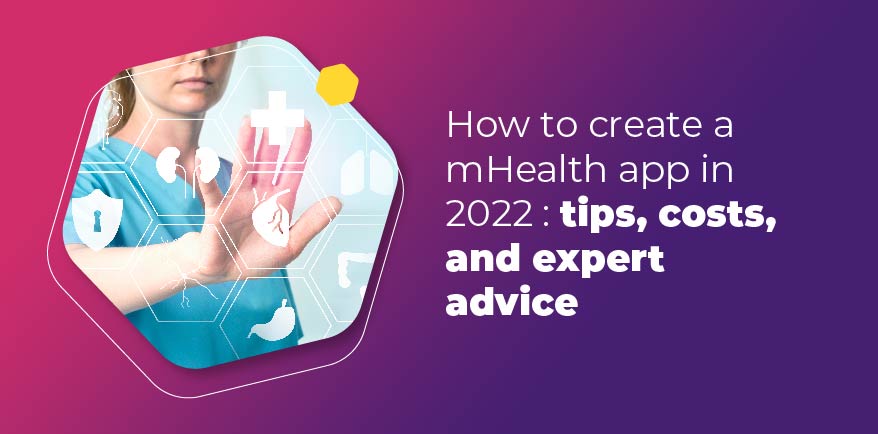As smartphones become more and more ubiquitous, the potential for mobile health (mHealth) apps to improve patient care is increasing. This post here will explore how to create a mHealth app in 2022, including tips on costs and expert advice.
Healthcare Mobile App – Features & Functionalities
The key features of mobile apps, similar to website design, are intuitive user experience and user interface. According to UMMC – Maryland Medical Center University,, “apps can be designed for any age group… they should be unfailingly easy to use.”
According to UMMC, mHealth tools range from data collection with mobile devices to using mobile devices as electronic health records. This data collection could include vital signs, personal medical information, or even diagnoses through well-labeled images.
UMMC sites examples of apps used for the diagnosis and treatment of disease, including apps that assess vision for cataracts or early detection of diabetic retinopathy, as well as apps that help asthma patients track their symptoms and inhaler use.
The American Heart Association (AHA) published a report in 2014 on the future of mHealth that includes a chapter on the types of devices that can be used for mHealth tools. According to AHA, “the most promising areas for mHealth development are those that target the primary care setting and prevention, such as mHealth tools providing virtual check-ins for patient follow-up.”
It also included a chapter on how mHealth can reduce hospital readmissions. According to AHA, “researchers have high hopes that mobile technology will help to reduce readmissions by providing patients with more intensive, patient-centered care management. These tools will provide remote monitoring of patient status and timely interventions as needed.”
AHA outlined key metrics that those who develop health apps should consider, including the patient’s comprehension of what they are supposed to do based on an app’s instructions and the app’s clinical efficacy.
The Myth Surrounding Mobile Healthcare Apps Development and Costs
Operating Systems For The mHealth App Development
An essential factor not to remember is when developing a mHealth app is which operating systems you need to support. According to AHA, “iOS and Android devices dominate the mobile market, and new models tend to be released periodically.” However, according to the AHA, the software for these devices is not always compatible.
AHA recommends “testing your mHealth app on several different types of mobile devices and then comparing usability and features across those devices.” This includes the Apple Watch as well as other wearable trackers. Operating Systems For The mHealth App Development
According to UMMC – Maryland Medical Center University, mobile devices range from smartphones to mobile medical devices used for patient monitoring.
In reality, there are different types of mobile devices available, but app development costs can vary depending on which device(s) you will need to support. According to AHA, “it’s critically important to keep in mind the cost of developing, deploying and maintaining a mobile app. This includes internal costs such as staff time for development and deployment, ongoing costs such as server maintenance and the method that will be required to support updates.”
Mobile Phone Medical Applications Market(Global) – Size, Trend & Forecast (2012 – 2022)
According to AHA, “it’s critically important to keep in mind the cost of developing, deploying and maintaining a mobile app.” This includes internal costs such as staff time for development and deployment, ongoing costs such as server maintenance, and the method required to support updates.
For example, AHA cites a study that found that “the most expensive part of mobile healthcare apps is the development and testing process, which takes about three times longer than traditional software development.” The study also found that “the cost of building a new mobile app is only slightly higher than the cost of modifying an existing web-based application to support mobile devices.”
Many researchers claim that “the costs of developing, deploying and maintaining mobility are lower than the benefits gleaned from improved care coordination, better patient engagement, improved safety, and quality.”
However, it also outlines external costs to consider when developing a mHealth app. This includes “adoption barriers such as reimbursement rate considerations,” which may consist of “establishing standards for interoperability, security, and privacy that are required to meet federal regulations.”
According to a recent report by Grand View Research, the global mobile app development market was valued at $ 89.9 billion in 2016 and is expected to reach $ 284.9 billion by 2022.
How much does it cost to develop a Healthcare app in 2022?
The development costs for a mHealth application are influenced by various elements and may vary depending on where the app developers are based.
From our experience in mobile app development, a simple digital health application for a single platform will cost $35,000-$90,000. Complex mHealth apps for several platforms will cost around $90,000-$150,000 (just the development phase). As a result, on average, a comprehensive error-free healthcare app from pre-build stage to launch and maintenance will cost $500,000.
Conclusion
Get in touch with us if you’re interested in developing mobile healthcare apps. Our professional staff will listen to your needs and recommend the best mobile healthcare app for you. We’ll give you clear insights based on your requirements and give you the most up-to-date technology.
We work with several clients to meet their various demands. As a result, the pricing is different and reasonable. Hire the top mobile healthcare app developers right now.
